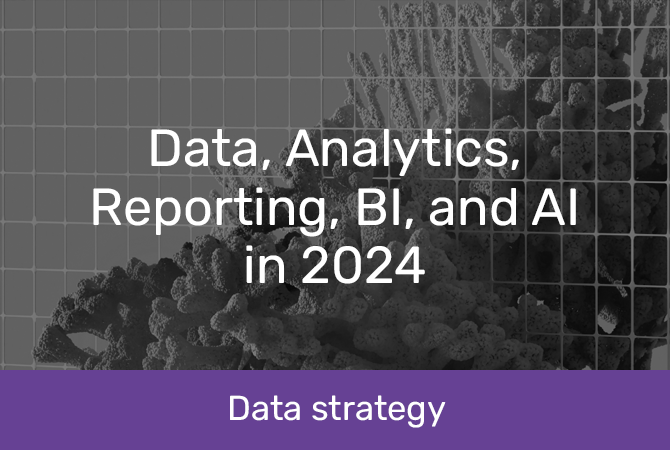![]()
Data, Analytics, Reporting, BI, and AI in 2024
what's in store?
The artificial intelligence boom since 2023 has changed the game – not just in the AI space but also in data, analytics, reporting, and business intelligence (BI). Becoming a data-driven organisation starts with having a clear definition of these terms.
A successful data strategy that delivers business advantage comes from developing your ability to use all five and integrating them together.
This article will provide you with a foundational understanding of data, analytics, reporting, BI, and AI – and our high-level predictions for them in 2024. Next month, we will reveal areas of opportunity and overlap when these areas converge. You can sign up to receive the Datafix newsletter and read our predictions from your inbox.
 datamine's 2024 data Predictions
datamine's 2024 data Predictions
The increased use of AI will profoundly impact the adoption of automation across most businesses. The promise of improved productivity driven by AI automation is likely to apply to all the areas explored in this article.
Our big four predictions for 2024 are:
- AI and machine learning will play an increasingly important role in BI, reporting, and data analytics
- Emphasis on real-time analytics
- More advanced data visualisation and reporting
- Increased focus on ethical considerations and responsible AI
Check your understanding of data, analytics, reporting, BI, and AI against our definitions below.
 definition of data
definition of data
Data is a collection of values and statistics available for analysis, reasoning or decision-making.
Most people have a reasonable understanding of what data is, but when it’s time to implement a data strategy for your business, it’s helpful to use precise definitions.
Data-driven organisations are better equipped to implement well-informed strategies, measure their performance, and achieve their goals. When a business proactively collects data, it rapidly becomes a large data set. There are many ways to store data, depending on how you intend to use it. Understand the difference between data warehouses, data lakes, data marts, and databases.
With the ever-increasing data production, prioritising data governance will be more important than ever in 2024. That means implementing internal data policies to ensure the ethical use of high-quality data in accordance with data and privacy regulations. The growing prevalence of AI tools will also influence how data is used and managed in analytics, reporting, and BI teams.
 definition of analytics
definition of analytics
Analytics is the science of taking raw data and translating it into something usable. It employs statistical and computational techniques and tools like spreadsheets, machine learning algorithms, and data visualisation software to enable analysis and comprehension of analytical findings.
The business analytics process requires steps, including gathering, refining, examining, saving, altering, modelling, and querying large data sets. Much of the process can be automated, which saves analytics teams a lot of time.
Businesses use analytics to understand what is and isn’t going well. These insights get applied to address areas of interest from cost reduction to customer targeting.
In 2024, analytics trends will gravitate towards automation, especially within companies where the analytics task is static (the same every time). For example, if your analytics task requires reading a data table each week, you want the table to have the same number of columns in a consistent format. Automating analytics by using AI and machine learning can help organisations improve efficiency, reduce manual errors, and support faster decision-making.
 definition of business reporting
definition of business reporting
Business reporting is the process of compiling and reviewing information within a functional area like sales, finance or operations. Reports are formal documents that focus on the status of a specific activity to show what has happened so far within a particular period (monthly, weekly, daily).
The primary purpose of reporting is to answer specific questions using predefined datasets. Insights from reports provide organisations with helpful information on growth, spending, and profits. They are designed to facilitate effective communication between teams who create the reports and teams who use them to support smart decision-making.
In 2024 AI technologies are likely to lead to increased automation in reporting tools. This may include automated data collection and visualisation so that organisations can reallocate time away from interpreting the insights towards making better informed decisions.
 definition of business intelligence
definition of business intelligence
Business intelligence (BI) is a term that describes the process of exploring data comprehensively to uncover insights and make strategic decisions. BI methodologies analyse, interpret, and translate data into information that drives organisational decision making.
Tools used in BI include data visualisation, monitoring, performance management, data mining, dashboards, and reports. All contribute to better understanding trends and getting insights into areas relevant to your business. They take the masses of raw data that companies collect and use them to visualise business performance, such as identifying areas of success and opportunities to improve.
By design, these strategies remove guesswork and enable better decision-making. The results or outcomes of BI strategies can also be described as business intelligence, because they are findings that inform how organisations can solve some of their most pressing problems and increase revenue.
The trend toward increased automation strongly influences the BI field, contributing to improved data quality and accessibility. Some of the ways in which BI is becoming more automated include data cleaning and predictive analytics.
 definition of artificial intelligence
definition of artificial intelligence
The definition of artificial intelligence (AI) keeps evolving as this young field experiences rapid change. At this stage (January 2024), AI is a methodology that solves problems using a combination of datasets and computer science.
What makes it unique is that, by design, AI replicates human-like abilities to perform tasks such as learning, reasoning, and decision-making. More and more businesses are adopting AI applications for uses, including:
- Chatbots/voice assistants to improve customer service
- Personalising marketing based on customer behaviour
- Customer satisfaction analysis
- Enhancing security by identifying business fraud
- Automating tasks and business processes
- Creating content with generative AI
As this technology evolves, there is likely to be an emergence of in-house, bespoke applications within organisations that cater to business functions and assist with the automation of analytics, reporting, and BI. While businesses are still approaching AI with caution, we assume that we will see AI begin to influence data-driven strategies significantly in 2024.
 Where to next?
Where to next?
In the evolving landscape of data-driven decision-making, there is a growing overlap between data, analytics, reporting, BI, and AI. Using data as your foundation, you can layer analytics, reporting, and BI to extract and leverage meaningful insights. AI plays a pivotal role in automating processes across these three and can deliver rapid outcomes for your business.
This cohesive consolidation can empower you to make well-informed decisions, uncover hidden data patterns, and adapt to changes in your business environment. In next month’s Datafix newsletter, we will be releasing a follow-up to this article that dives further into the opportunities that arise when you use integrated data solutions across data, analytics, reporting, BI, and AI.
Have you got a colleague who should read the follow-up article? Subscribe them to Datamine's Datafix newsletter.
Subscribe to Datafix
Do you want to go beyond guesswork to implement smart, data-driven business strategies? Then, don't miss our monthly Datafix newsletter. Fill out the form below to subscribe.














































